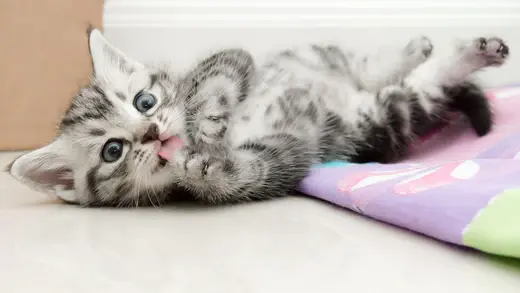Your Complete Guide to Dealing with Cat Hairballs

All cat owners know that, unfortunately, hairballs are inevitable. While they're unpleasant, hairballs are a normal part of a cat’s grooming routine. However, hairballs can sometimes signal an underlying health problem. It's important to understand what they mean and how to prevent them.
What Are Cat Hairballs?
You’ve seen them on your floor (and maybe, unfortunately, on other surfaces, too). You’ve cleaned them up. But what actually is a hairball?
Essentially, a hairball is a small lump of undigested hair and digestive liquid. Occasional hairballs are normal — they’re a way for your cat to get rid of undigested hair or fur in the stomach caused by the grooming process.
Some cats are more prone to hairballs than others. The older your cat gets, the more likely it is to develop more hairballs; this is because older cats tend to groom themselves more often than young ones. Long-haired breeds also tend to get more hairballs than short-haired cats. And all cats generally develop more hairballs during the times of year when they’re shedding.
Why Do Cats Get Hairballs?
When your cat licks and cleans itself, they generally swallow some fur. Your cat has something called papillae on its tongue: tiny spines that store saliva. These spines point backward, making it easy for fur to slide down your cat’s throat.
Cats digest most of the fur that they swallow and then excrete it. Some of that fur doesn’t get digested — it forms into a wad instead, and eventually, it’s going to come back up.
Can Hairballs Be Dangerous?
If your cat regularly throws up hairballs, you might be getting concerned. Don’t worry if they throw up a hairball as often as once a week. This is normal. But if your cat continually tries to throw up with no hairball appearing or if your cat is not eating, it’s important to immediately contact your vet.
Cats will sometimes get an intestinal blockage from hairballs. When this happens, the hairball moves into your cat’s intestine but then gets stuck. These blockages can sometimes be life-threatening. Your cat may need surgery to correct the issue.
What’s more, hairballs can sometimes be a sign of an underlying health issue, such as anxiety or allergies that leading your cat to groom too often. Frequent hairballs could also signal gastrointestinal disease or lung disease. If you have any concerns about your cat’s hairballs, make an appointment with your vet right away.
How to Prevent Hairballs in Cats
You can take simple measures at home regarding hairball control for cats. Brush your cat regularly (ideally, once a day) so there won’t be as much loose hair for them to swallow. Speak with your vet about the best diet for hairball control for cats. Use products such as Skout’s Honor Probiotic Detangler to help manage shedding and matting and prevent hairballs. We also offer sanitizing and cleaning solutions to take care of those normal hairballs your cat throws up from time to time.
Hairball Control for Cats
Although cat hairballs can sometimes signal an underlying health issue, in most cases, they’re a normal part of your cat’s grooming routine. Speak with your vet if you have any concerns and take steps for hairball prevention at home.
Hailey Hudson is a full-time freelance writer and content marketer based out of Atlanta, Georgia, where her cat acts as her co-worker and supervisor. She writes about pet-based topics for clients such as PetFirst Pet Insurance, Just Labs Magazine and Pet Product News.
References
- Cornell University: A Hairy Dilemma, https://www.vet.cornell.edu/departments-centers-and-institutes/cornell-feline-health-center/health-information/feline-health-topics/hairy-dilemma
- Purina: How to Deal with Cat Hairballs, https://www.purina.co.uk/cat/purina-one/advice/health/article/dealing-with-cat-hairballs
- Animal Hospital of North Asheville: Is it Hairballs or a Sign of Something More Serious?, https://www.ahna.net/site/blog-asheville-vet/2020/03/30/it-hairballs-or-sign-something-more-serious



